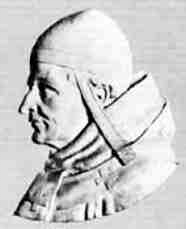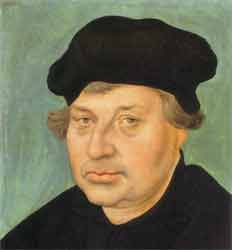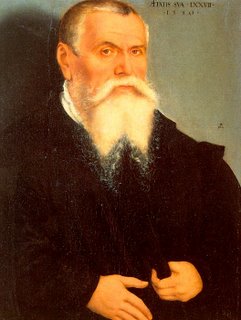 The book of Acts mentions a Mark, or John Mark, later called a kinsman of Barnabas (Colossians 4:10). The house of his mother Mary was a meeting place for Christians in Jerusalem (Acts 12:12). When Paul and Barnabas, who had been in Antioch, came to Jerusalem, they brought Mark back to Antioch with them (12:25), and he accompanied them on their first missionary journey (13:5), but left them prematurely and returned to Jerusalem (13:13).
The book of Acts mentions a Mark, or John Mark, later called a kinsman of Barnabas (Colossians 4:10). The house of his mother Mary was a meeting place for Christians in Jerusalem (Acts 12:12). When Paul and Barnabas, who had been in Antioch, came to Jerusalem, they brought Mark back to Antioch with them (12:25), and he accompanied them on their first missionary journey (13:5), but left them prematurely and returned to Jerusalem (13:13).When Paul and Barnabas were about to set out on a second missionary journey, Barnabas proposed to take Mark, but Paul thought him unreliable, so that eventually Barnabas made one journey taking Mark, and Paul another journey taking Silas (15:36-40). Mark is not mentioned again in Acts. However, it appears that he became more reliable, for Paul mentions him as a trusted assistant in Colossians 4:10 and again in 2 Timothy 4:11.
The Apostle Peter had a co-worker whom he refers to as "my son Mark" (1 Peter 5:13). Papias, an early second century writer, in describing the origins of the Gospels, tells us that Mark was the "interpreter" of Peter, and that he wrote down ("but not in order") the stories that he had heard Peter tell in his preaching about the life and teachings of Jesus. Debate continues as to the veracity of some of Papias' records, but this one is considered genuine by many scholars.
The Gospel According to Saint Mark, in describing the arrest of Jesus (14:43-52), speaks of a young man who followed the arresting party, wearing only a linen cloth wrapped around his body, whom the arresting party tried to seize, but who left the cloth in their hands and fled naked. Many think that this young man was the writer himself, since the detail is hardly worth mentioning if he were not.
Tradition holds that after Peter's death, Mark left Rome and went to preach in Alexandria, Egypt, where he was eventually martyred.
It is natural to identify the John Mark of Acts with the Gospel-writer and interpreter of Peter, and this identification is standard in liturgical references to Mark. However, "Mark" is the commonest of Latin first names, and they may well have been separate people.
Mark's symbol in Christian art is a often a lion, usually winged. In Revelation 4 and throughout much of his vision, John sees about the throne of God four winged creatures — a lion, an ox, a man, and an eagle. (Compare with the beings in Ezekiel 1 and 10.) Custom supposes that these represent the four Gospels or the four Evangelists (Gospel-writers).
One way to match the creatures with the Evangelists is to say that the man stands for Matthew, whose narrative begins with the human genealogy of Jesus and who often quotes Christ speaking of Himself as "the Son of Man"; the lion stands for Mark, whose narrative begins with John the Baptist crying out in the desert (a lion roars in the desert); the ox, a sacrificial animal, stands for Luke, whose narrative begins in the Temple; the eagle, then, stands for John, whose narrative begins in Heaven with the eternal Word and who writes in a lofty style.
Lection
Psalm 146
Isaiah 52:7-10
2 Timothy 4:5-18
Mark 16:14-20
Collect
O almighty God, You have enriched Your Church with the proclamation of the Gospel through the evangelist Mark. Grant that we may firmly believe these glad tidings and daily walk according to Your Word; through Jesus Christ, Your Son, our Lord, who lives and reigns with You and the Holy Spirit, one God, now and forever.
Technorati Tags: Saint Mark | St. Mark | Mark | winged lion | evangelist | Jesus | Jesus Christ | Christ | Nazareth | Church Year | liturgical calendar | Christianity | Christian feasts | biography | hagiography | historical theology | Church history | Bible history | New Testament | Gospel | Aardvark Alley
 Johann Walter (also Johannes Walther) was born in 1496 and began serving at the age of 21 as a composer and bass singer in the court chapel of Frederick the Wise. In 1524, he published a collection of hymns arranged according to the church year. It was well received and served as the model for numerous subsequent hymnals.
Johann Walter (also Johannes Walther) was born in 1496 and began serving at the age of 21 as a composer and bass singer in the court chapel of Frederick the Wise. In 1524, he published a collection of hymns arranged according to the church year. It was well received and served as the model for numerous subsequent hymnals.In addition to serving for 30 years as kantor (church musician and choir director) in the cities of Torgau and Dresden, he also assisted Martin Luther in the preparation of the Deutsche Messe of 1526, a setting of the Liturgy to hymns in the German language.
Walter is remembered as the first Lutheran kantor and composer of church music. Among his most cherished works is Der Bräut'gam wird bald rufen (The Bridegroom Soon Will Call Us). Information on Walter, including some texts and music samples, may also be found through Hymnuts, Here of a Sunday Morning, and the Cyber Hymnal.
NB: Do not confuse this Johann Walter, whose output was largely hymns and other church music with the later Johann Jakob Walther (1650 - 1717), a Baroque composer best known for his violin works, or with Johann Gottfried Walther (1684 - 1748), also from the Baroque Period, who was a church organist and composer.
Technorati Tags: Johann Walter | Johannes Walther | composer | Martin Luther | liturgical theology | Lutheran | music | kantor | hymnody | Church Year | liturgical calendar | Christianity | biography | hagiography | historical theology | Church history | European history | German history | Reformation history | Aardvark Alley
 Thanks to all those who continue to blog, especially to our new editions. We have a six brand new entries, one that's returned after a brief absence, one with a new URL, and one bearing new name and address. There are no current deletions to the Big Blogroll O' Vark®™©.
Thanks to all those who continue to blog, especially to our new editions. We have a six brand new entries, one that's returned after a brief absence, one with a new URL, and one bearing new name and address. There are no current deletions to the Big Blogroll O' Vark®™©.If you're not sure what to make of the BBOV or wonder about the benefits of being listed and of listing others' blogs, please read the first three links under Aurous Effluence in the sidebar. Those who'd like the Big Blogroll O' Vark®™© can either email me or copy the list from the Alley's source code (click View | Page Source or Control+U in Firefox or View | Source in Internet Explorer).
NEW KIDS ON THE BLOCK
† Angry Lutherans — LCMS and WELS tag-team rants
† The Blog of St. Mark — Sermons and comments from Duncanville, Texas
† Confessional's Bytes — Back from the dead
† Hemmersphere — Pastor Jeff Hemmer
† The Lutheran Grandson, U.A.C. — "in defense of my grandfather's faith"
† Real Choice — Fighting for the unborn ... and their mothers
† Sci-fi Theologica — Written and illustrated by Tim Baron
A BIT O' CHANGE
† StarboCho — Was Steven Cholak's Crowned Ones
† Three Taverns — new URL
LAST WORDS
For all those enrolled in the BBOV, links back are certainly appreciated. And don't forget that all of those listed benefit when you use the entire blogroll. Also, if you'd like to graphically point to the Alley and the Big Blogroll O' Vark®™©, you may use the above design from St. Charles the Illuminous or one of these blog buttons:
Finally, if you own or know of a Lutheran blog demonstrating a quia confessional subscription and would like me to consider it for inclusion, please leave a comment. And again, for more information about why this stuff benefits confessional Lutheran blogging, morality, and other worthwhile endeavors, please check out the first three links under Aurous Effluence in the sidebar.
Technorati Tags: Aardvark Alley | Big Blogroll O' Vark®™© | BBOV | blogroll | blog roll | Lutheran | confessional Lutheran
 Known as the father of medieval Scholasticism, Anselm was born in Italy in 1033. Most closely associated with England, he first served as prior and abbot of the Benedictine Abbey in Bec, Normandy, later becoming Archbishop of Canterbury for many years.
Known as the father of medieval Scholasticism, Anselm was born in Italy in 1033. Most closely associated with England, he first served as prior and abbot of the Benedictine Abbey in Bec, Normandy, later becoming Archbishop of Canterbury for many years.A brilliant scholar and writer who loved the works and followed in the way of Augustine, Anselm used his political skills with the British kings on behalf of the established Christian Church, affirming that it is the leadership of the Church and not the state which has the responsibility of establishing structure and maintaining order among the clergy.
Anselm's book Cur Deus homo (Why God Became Man) expresses his thoughts on Christ's atonement and taught that the reason for the incarnation was that Jesus, the Son of God, would suffer and die in place of sinners. His Monologium shows the beginnings of his ontological argument for the existence of God. He further developed this philosophical argument in the Proslogion (also spelled Proslogium).
He was canonized in 1494 by Pope Alexander VI.
More at the Christian Cyclopedia, Wikipedia, and James Kiefer's Hagiographies.
Lection
Psalm 139:1-9 or 37:3-6,32-33
Romans 5:1-11
Matthew 11:25-30
Collect
Almighty God, who raised up Your servant Anselm to teach the Church of his day to understand its faith in Your eternal Being, perfect justice, and saving mercy, provide Your Church in every age with devout and learned scholars and teachers, that we may be able to give a reason for the hope that is in us; through Jesus Christ our Lord, who lives and reigns with You and the Holy Spirit, one God, now and forever.
Technorati Tags: Saint Anselm of Canterbury | Saint Anselm | St. Anselm | Anselm | Archbishop of Canterbury | Scholasticism | ontological argument | atonement | Christology | dogmatics | apologetics | systematic theology | Incarnation | Cur deus homo | Why God Became Man | Church Year | liturgical calendar | Christianity | Christian feasts | biography | hagiography | historical theology | Church history | European history | English history | British history | Aardvark Alley
 Johannes Bugenhagen (1485-1558), was from Pomerania in northern Germany. Because of his ancestral region, he took the Latin name Pomeranus and Martin Luther often called him "Doctor Pommer."
Johannes Bugenhagen (1485-1558), was from Pomerania in northern Germany. Because of his ancestral region, he took the Latin name Pomeranus and Martin Luther often called him "Doctor Pommer."He was appointed pastor of Wittenberg in 1523 through the efforts of Luther and thus served as the reformer's pastor and confessor. One of the greatest scholars of the Reformation era, he helped translate the New Testament into Low German and wrote a commentary on the Psalms. He also worked to organize the Lutheran Church in northern Germany and Denmark, journeying to Copenhagen where he crowned both King and Queen and consecrated seven men to the offices of superintendent and bishop.
For those who think that their pastors preach too long, you share that complaint with Luther, who described Pomeranus' preaching as "whatever comes to mind, much like a maidservant chatting with another at the market." One story says that Luther recommended Bugenhagen cut his sermons in half and preach no more than an hour, lest all minds wander.
More information is available through the Christian Cyclopedia and Wikipedia.
Lection
Psalm 46
Isaiah 55:6-11
Romans 10:5-17
John 15:1-11
Collect
O Lord God, heavenly Father, who called Johannes Bugenhagen as pastor and confessor of the Faith, grant us faithful pastors in our time; pour our Your Holy Spirit on Your faithful people, keep them steadfast in Your grace and truth, protect and comfort them in all temptation, defend them against all enemies of Your Word, and bestow on Christ's Church Militant Your saving peace; through Jesus Christ, Your Son, our Lord, who lives and reigns with You and the Holy Spirit, one God, now and forever.
Technorati Tags: Johannes Bugenhagen | Docter Pommer | Pomeranus | Reformation | Lutheran Reformation | Martin Luther | Church history | historical theology | Lutheran | Lutheranism | German history | European history | Church Year | liturgical calendar | Christianity | Christian feasts | biography | hagiography | Aardvark Alley
 Albrecht Dürer (1471-1528), a native of Nuernberg, Germany, was one of the most learned of Renaissance artists and ranked among the great minds of Humanism. His paintings and woodcuts include examples of the splendor of creation and skilled portrayals of biblical narratives.
Albrecht Dürer (1471-1528), a native of Nuernberg, Germany, was one of the most learned of Renaissance artists and ranked among the great minds of Humanism. His paintings and woodcuts include examples of the splendor of creation and skilled portrayals of biblical narratives.While great beauty and form characterize his paintings, most know him best for his woodcuts and etchings, often produced in extended series format. The Concordia Historical Institute displayed two of these series in one show: His "Life of Mary" and "Small Passion" were shown in an exhibit entitled A Sword Will Pierce Your Own Soul Too. CHI made digital copies of the individual works and they may be viewed by following the link.
Dürer never renounced Roman Catholicism, although his later writings and paintings show great sympathy toward the Reformation and ardent admiration for Martin Luther.
16 October AD 1553
 Lucas Cranach (1472-1553), a close friend of Martin Luther, was a celebrated painter of portraits and altar pieces and a producer of woodcuts of religious subjects.
Lucas Cranach (1472-1553), a close friend of Martin Luther, was a celebrated painter of portraits and altar pieces and a producer of woodcuts of religious subjects.Among his portraits are some of the most noted depictions of Martin and Katy Luther and Luther's co-worker Philipp Melanchthon. He also did a number of works from Greco-Roman mythology, Biblical and hagiographic scenes, and portrayed a number of wealthy people from his time.
Among his most noted works is the altarpiece from Weimar, often thought to have been completed by his son, Lucas Cranach the Younger. The painting depicts Old and New Testament themes centering on Law and Gospel and on the crucifixion and resurrection of Christ. Cranach's intentional anachronism of including himself, Martin Luther, and John the Baptizer at the foot of the cross shows how the Church always points to Christ and benefits from His suffering and death.
Some later scholars have tried to depict Cranach as a misogynist. However, examination of his writings and the content of his paintings allows little credence for this theory.
18 February AD 1564
 During roughly the same time that Cranach and Dürer worked in Germany, Florentine artist Michelangelo Buonarroti (1475-1564) was busy in Italy. By age 21, he'd already carved his famous Pietà, a scene of the Virgin holding her dead Son before His burial. Most will probably know him from his statue of David and his work in the Sistine Chapel.
During roughly the same time that Cranach and Dürer worked in Germany, Florentine artist Michelangelo Buonarroti (1475-1564) was busy in Italy. By age 21, he'd already carved his famous Pietà, a scene of the Virgin holding her dead Son before His burial. Most will probably know him from his statue of David and his work in the Sistine Chapel.The picture here is from his "Last Judgment" fresco; the person portrayed is Saint Bartholomew, holding the knife said to have flayed him in one hand and his peeled skin in the other. I include it because the face of the restored saint is a self-portrait by Michelangelo. Many have speculated as to why he chose this particular person to bear his image. Some think he used it to indict those who criticized him, as if to say, "You can cut away at me now, but I will be vindicated." Others believe that he wrestled throughout his life with temptation and sinful behavior but recognized that in the Resurrection he would be remade.
Both Cranach and Dürer are remembered and honored for the grandeur of their works of art that depict the glory and majesty and the grace and mercy of the triune God. We've also included Michelangelo, although his life (both public and private) sometimes was contrary to Scripture's standards of godliness.
Collect
O God, who by your Holy Spirit give to some the word of wisdom, to others the word of knowledge, and to others the word of faith, we praise You for the gifts of proclaiming Your grace and glory through visual representation that you gave to your servants Albrecht Dürer, Lucas Cranach, and Michaelangelo Buonarroti, and we pray that Your Church may never be destitute of such gifts; through Jesus Christ our Lord, who lives and reigns with You and the Holy Spirit, one God, now and forever.
Technorati Tags: Duerer | Albrecht Duerer | Dürer | Albrecht Dürer | Durer | Albrecht Durer | Cranach | Lucas Cranach | Michelangelo | Michelangelo Buonarroti | art | vocation | Church Year | liturgical calendar | Christianity | Christian feasts | biography | hagiography | historical theology | Church history | European history | art history | Aardvark Alley

